These are true bakery-style croissants…soft, buttery, and golden brown…but made with simple, everyday ingredients you already have at home. They take time, yes, but every step is worth it when you pull that first tray from the oven and see those perfect, crisp layers. Let’s make the best homemade croissants you’ve ever had.
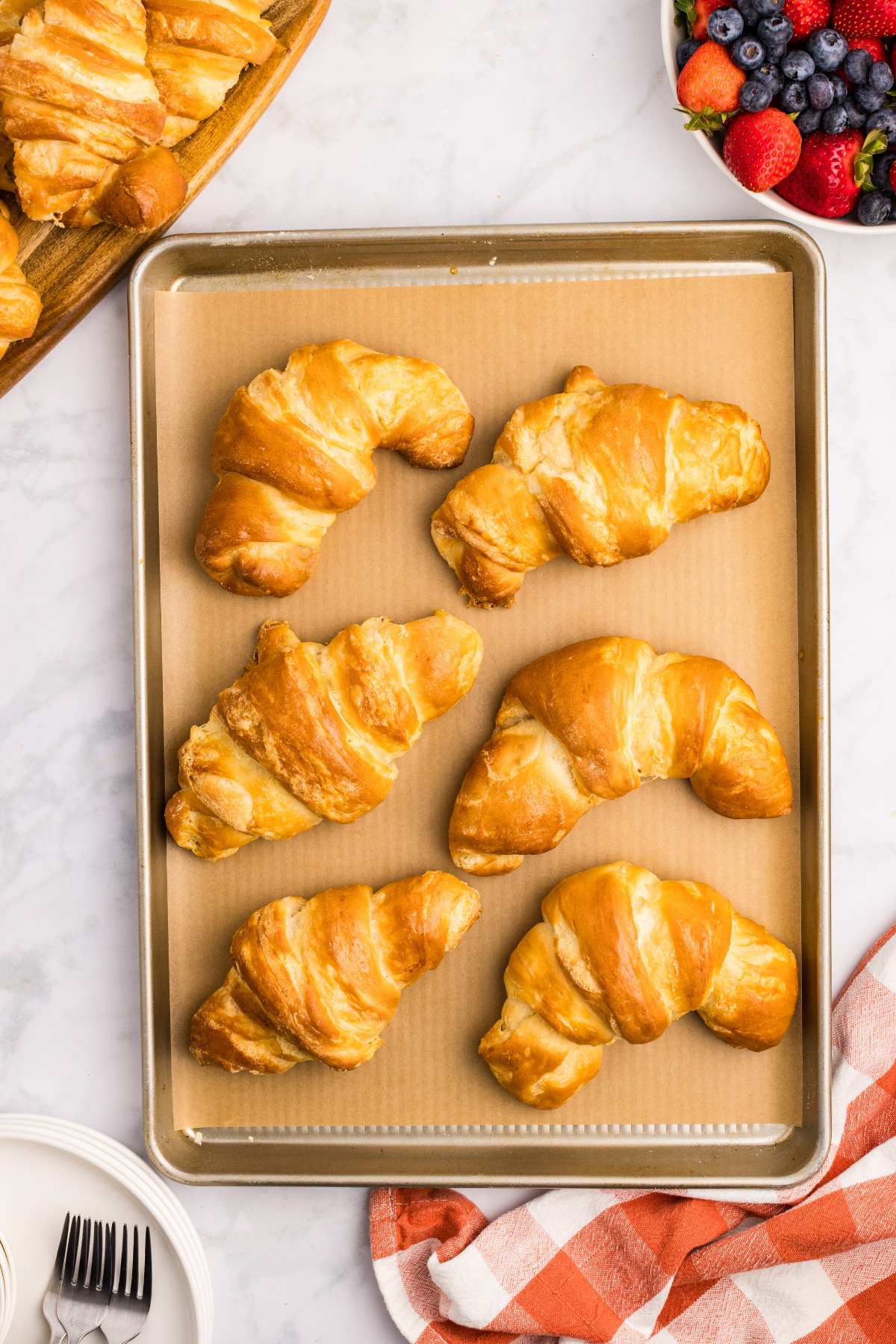
Croissants look like an all-day project, but really, it’s just a few short steps spaced out over time. I’ll usually start the dough in the afternoon (mix, roll, fold) and then tuck it into the fridge overnight. In the morning, all that’s left is to shape, rise, and bake while the coffee’s brewing. It’s not hours of nonstop work, just little bits of effort.
Table of Contents
What You’ll Need
If I happen to have an expensive European butter (Kerrygold brand or similar) on hand, I’ll use it. Otherwise your everyday kind is fine.
I have never had luck doubling this recipe because the laminating step gets out of hand. That’s not to say it can’t be done, especially if you have a heavy duty mixer and a big countertop. If you’d like to double it, you can make adjustments in the recipe card at the bottom of this post.
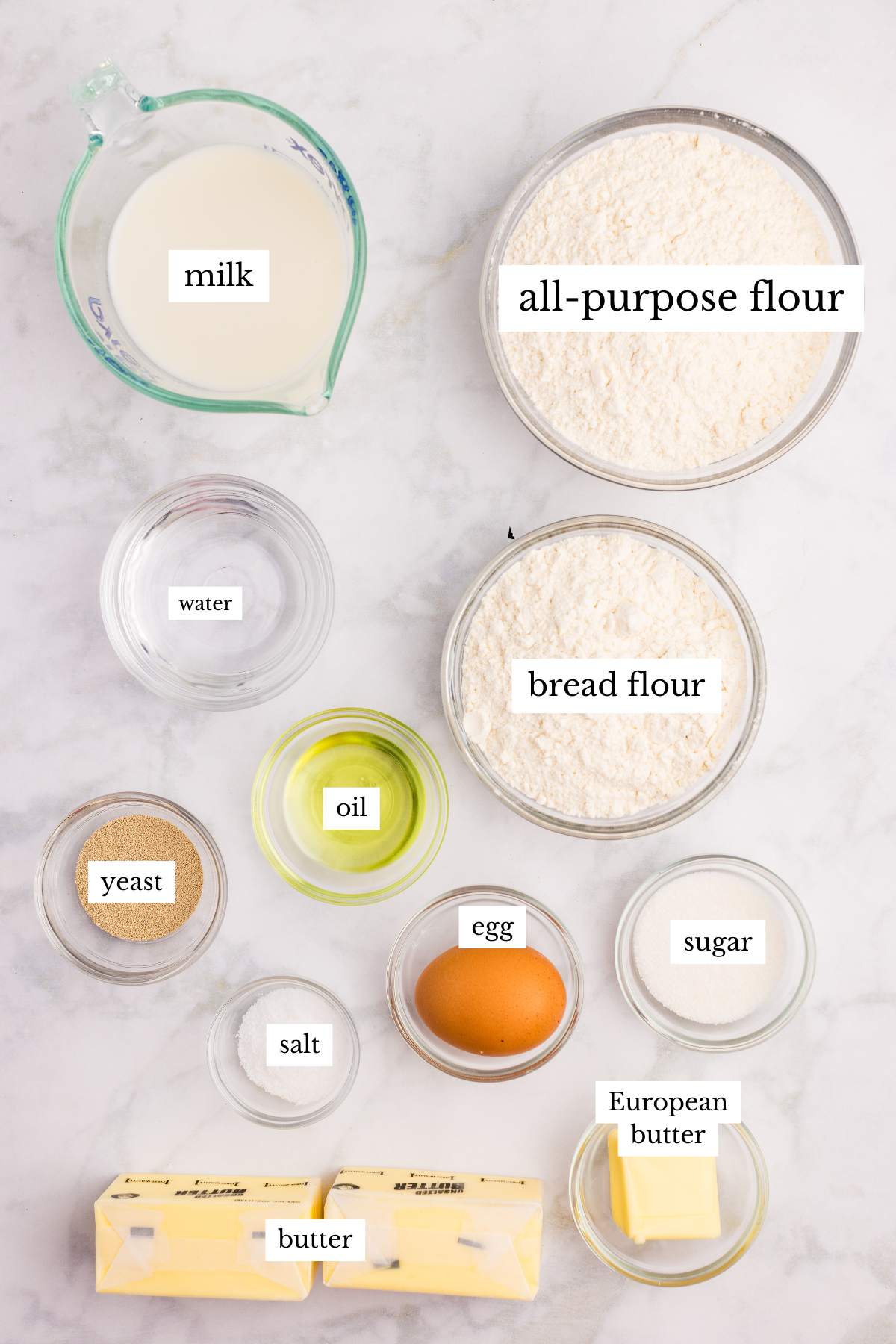
Equipment
- Stand mixer with dough hook and paddle attachments you can mix by hand, but it’s a workout and takes longer to knead properly.
- Rolling pin
- Half sheet pans (2)
- Parchment paper or plastic wrap
- Pizza cutter or sharp knife A bench scraper also works if it’s sharp enough.
- Pastry brush
For the Dough
- 2 ¼ teaspoons dry active yeast or instant yeast
- ¼ cup warm-ish water
- 2 tablespoons granulated sugar
- 1 cup warm milk (2% or whole milk both work well)
- 1 ½ teaspoons salt
- 1 cup bread flour
- 2 ½ cups all-purpose flour (+ more for rolling)
- 2 tablespoons unsalted butter, room temperature
- 2 tablespoons avocado oil or another neutral-flavored oil
For the Butter Dough
- 2 tablespoons all-purpose flour
- 1 cup (2 sticks) unsalted butter, softened
For the Egg Wash (Optional)
- 1 tablespoon water
- 1 egg
Instructions
1. Start the Dough
Add the warm milk, yeast, salt, and bread flour, and mix with the dough hook until everything is smooth. Then slowly add the all-purpose flour, about ½ cup at a time, until the dough pulls away from the sides but still feels slightly sticky.
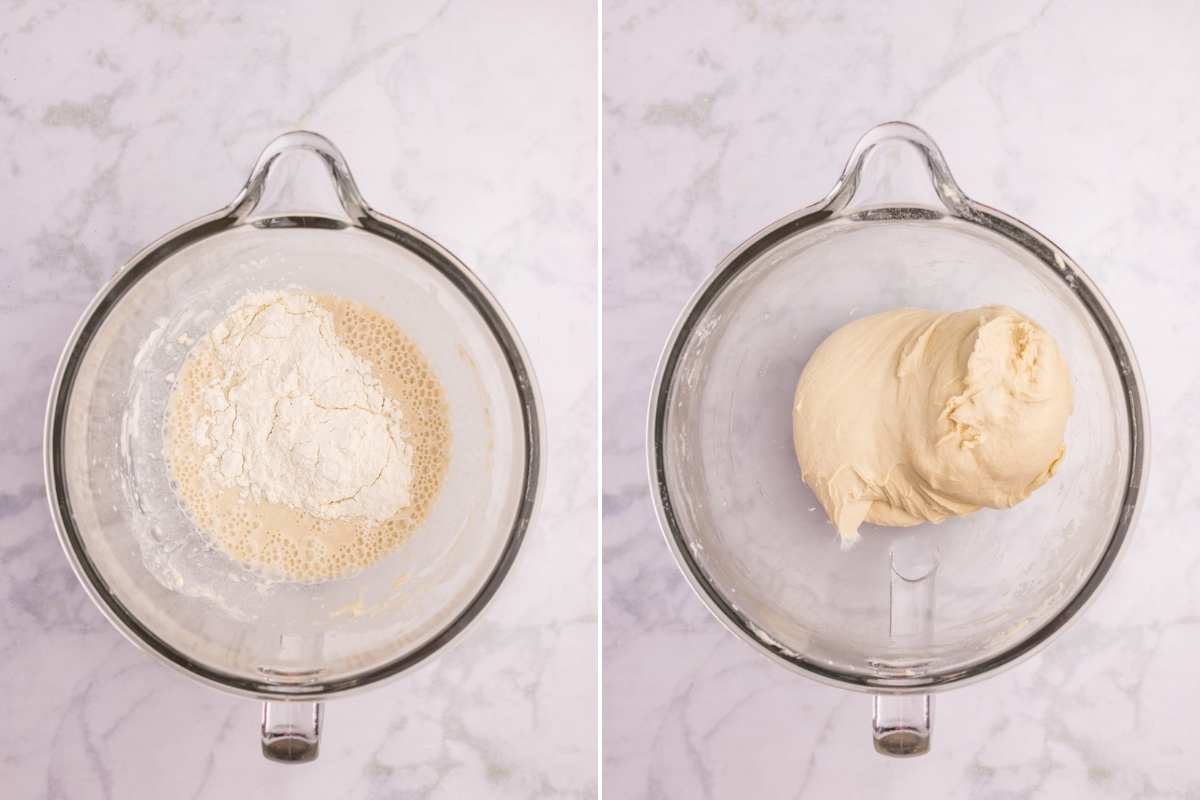
Once the flour is in, add the butter and let the mixer knead for about 5 minutes.
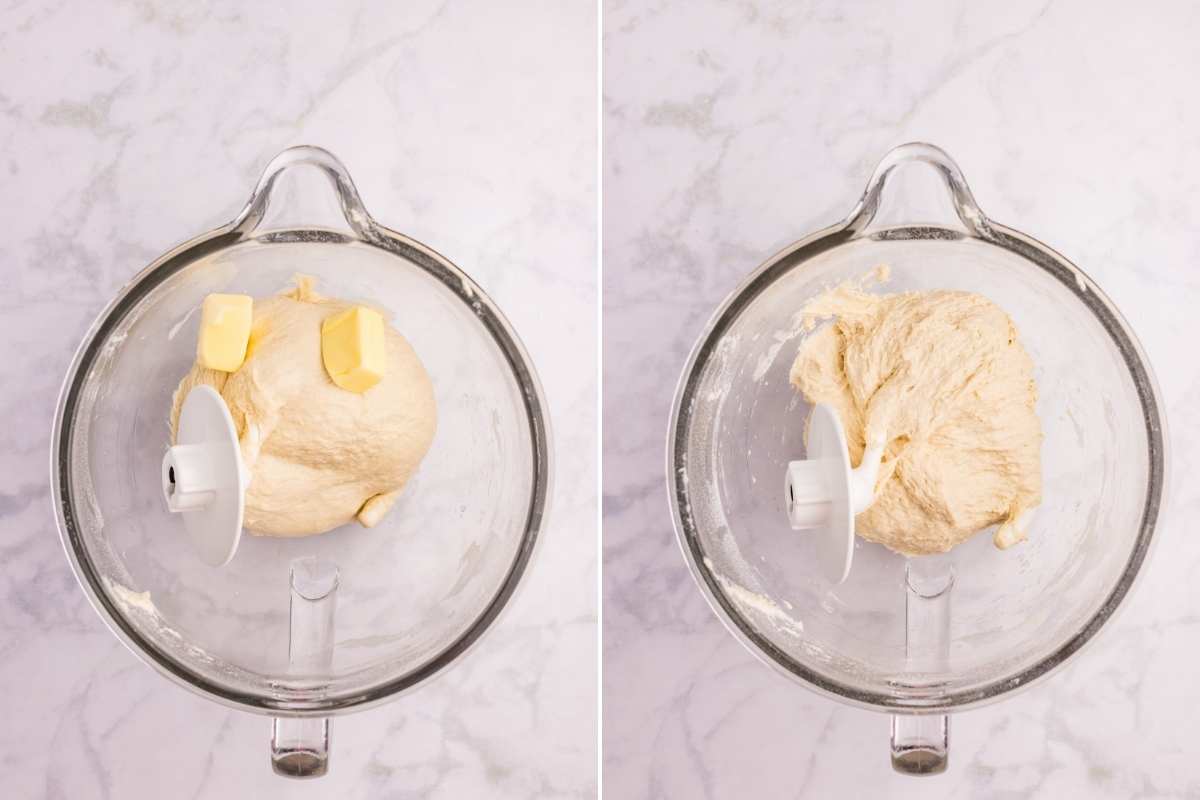
The dough should look smooth and soft. Still tacky but not clinging to your hands.
2. First Rise
Oil a clean bowl with about 1 tablespoon of avocado oil and place your dough inside. Drizzle the remaining oil over top and turn the dough once so it’s lightly coated all over. Cover with plastic wrap or a damp towel and let it rise in a warm spot until doubled in size, about 2 hours.
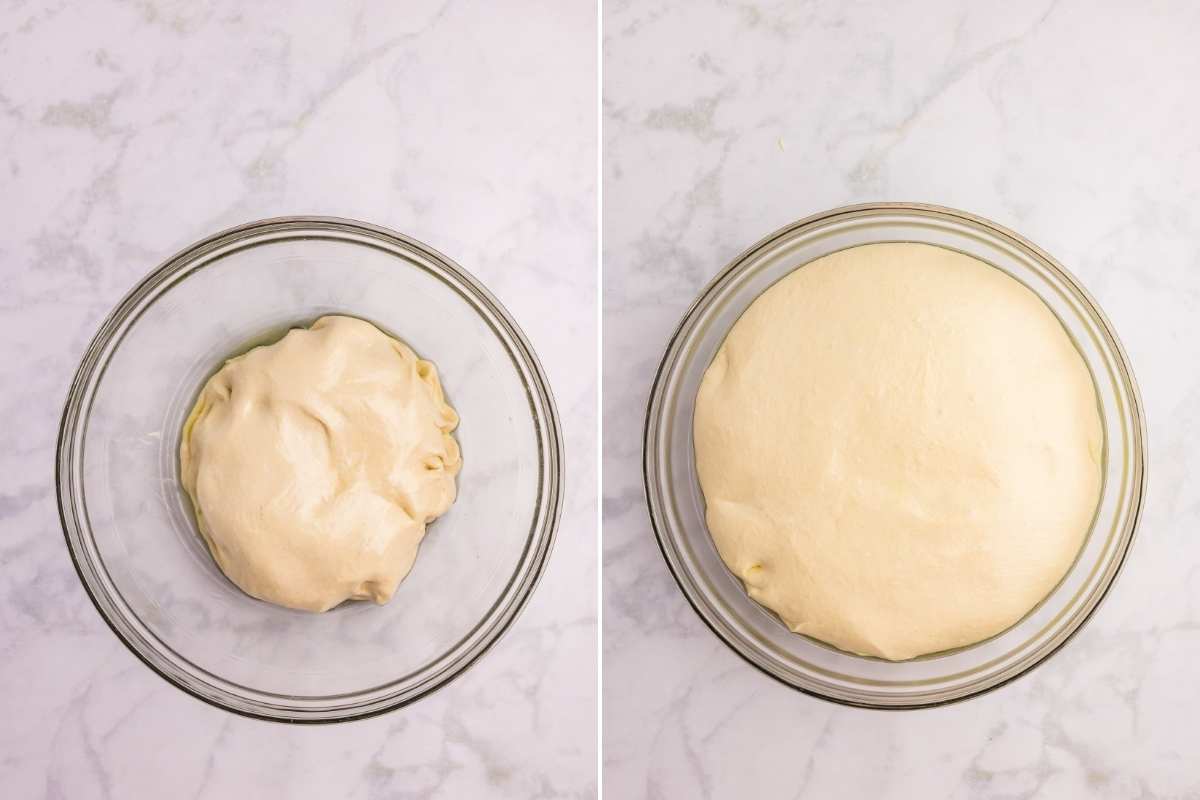
A cold kitchen will slow this down. You can set the bowl in a slightly warmed up (but turned off!) oven.
But while it rises, we have work to do!
3. Make the Butter Block
While the dough rises, make your butter dough. In your mixer, beat together the flour and softened butter until smooth and spreadable. Transfer it onto a piece of parchment paper and shape it into a rectangle about 8×13 inches or roughly half the size of a baking sheet.
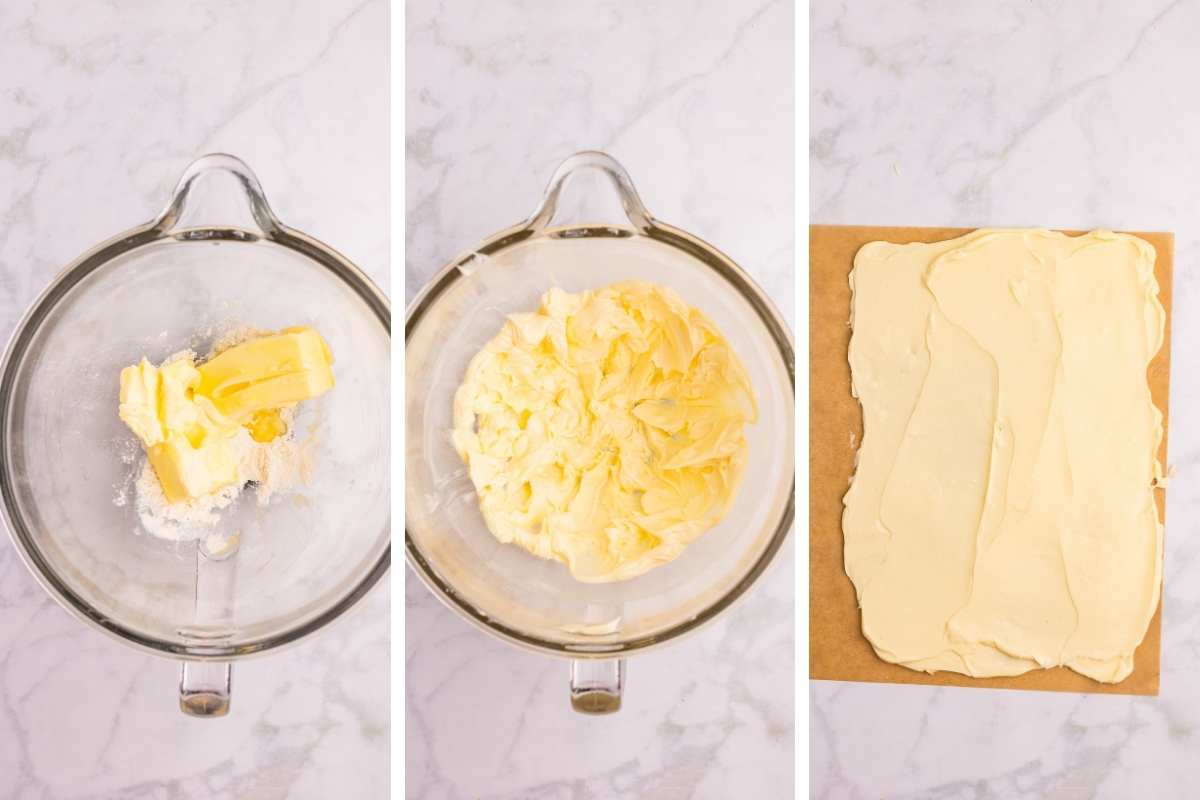
If the butter feels sticky, refrigerate it for 5–10 minutes before spreading. You want it firm but flexible, not melting.
Wrap it up and chill until your main dough has risen.
4. Laminate the Dough (the layering magic)
Once the dough has doubled, turn it out onto a floured surface and roll it into a large rectangle, about 18×26 inches. Place the chilled butter block over one half of the dough and fold the other half over it, sealing the edges.
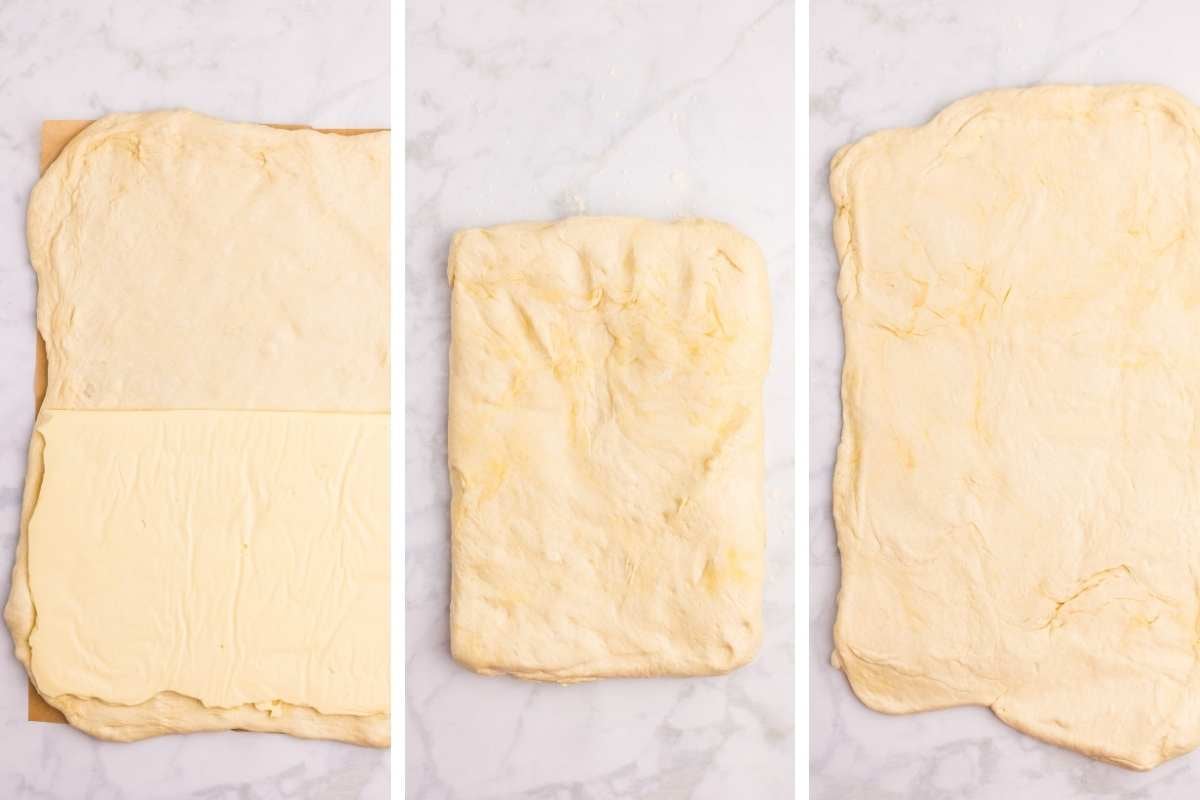
Refrigerate for 30 minutes to relax the gluten and firm the butter.
Then begin your folding process: roll it out again into a large rectangle, fold it into thirds (like a letter), cover, and chill again for 30 minutes.
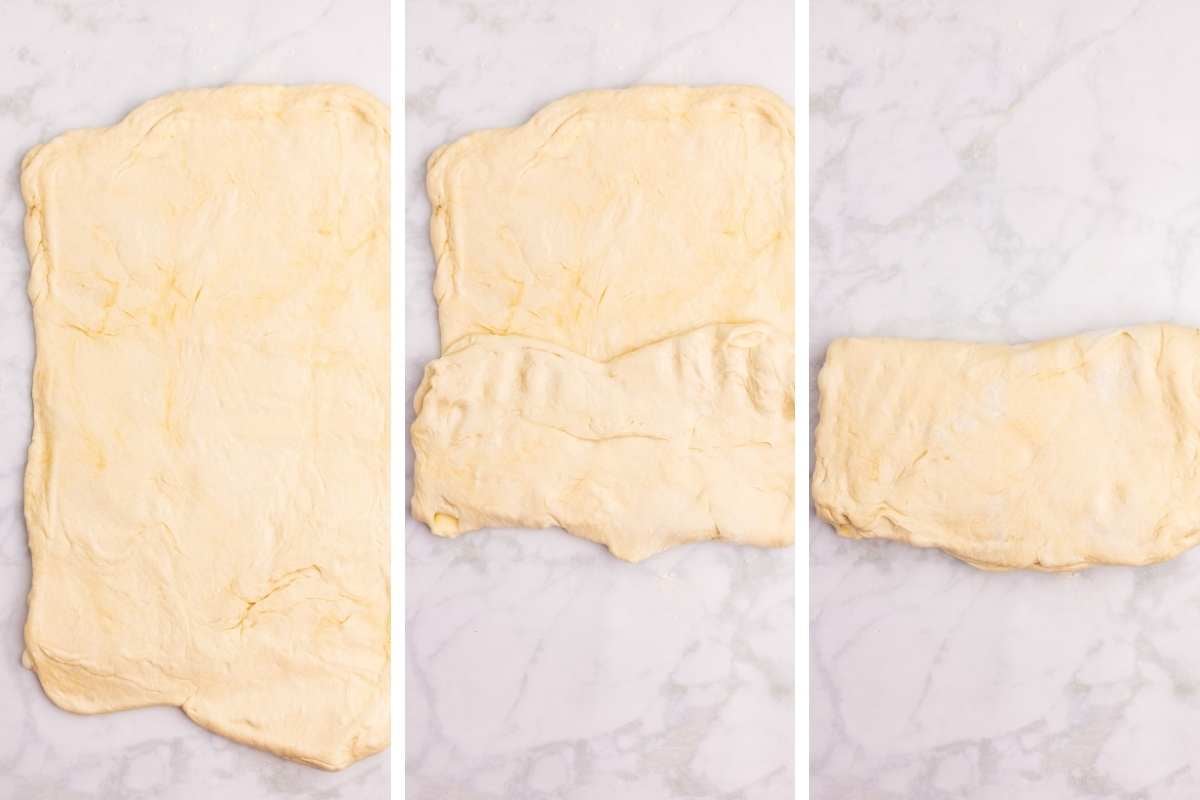
Repeat this rolling–folding–chilling cycle three more times for a total of four folds.
If at any point the butter starts peeking through or feels too soft, stop and chill it again. This step is what creates those beautiful, flaky layers, so patience here really pays off.
5. Shape the Croissants
After the final chill, roll the dough into a large rectangle about ½ inch thick. Trim the edges if they’re uneven.
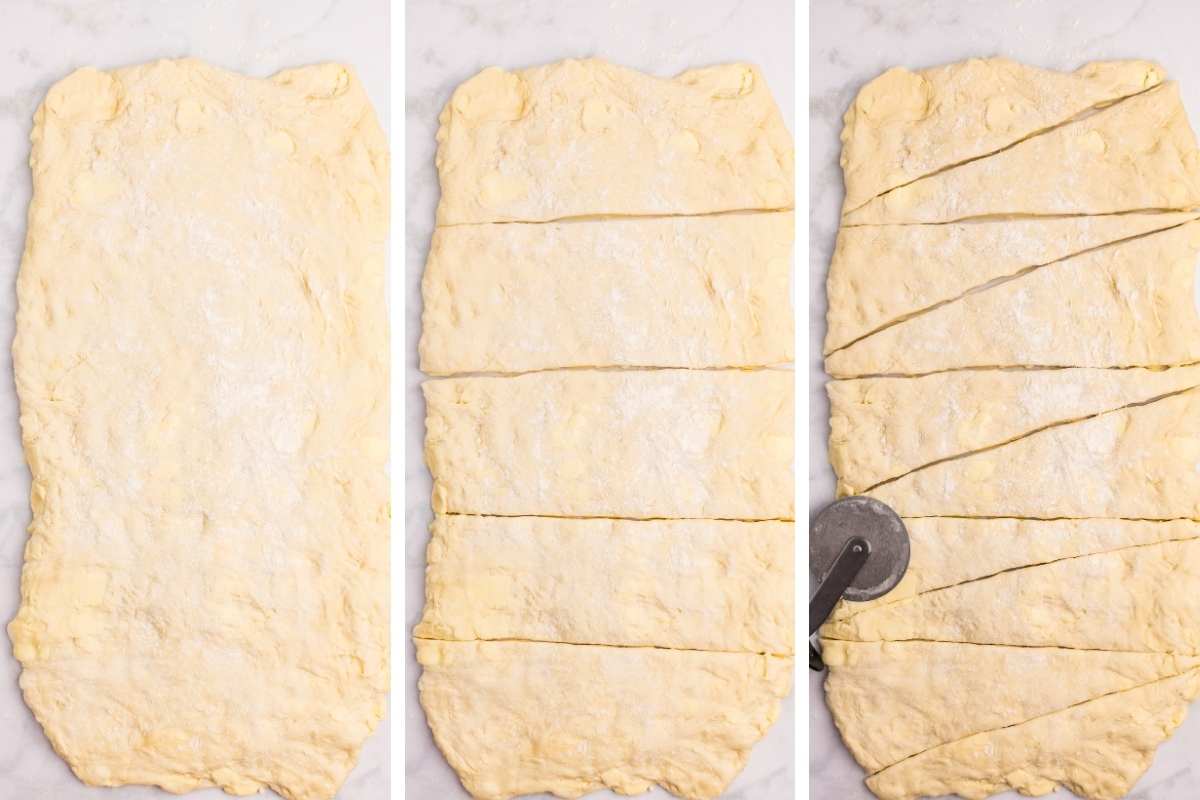
Cut the dough into 6 equal strips, then cut each strip diagonally to make 12 triangles. Cut a small 1-inch slit at the wide end of each triangle (this helps them roll neatly), then roll from the wide end toward the tip, forming a crescent shape.
Don’t roll too tight! If they’re snug, the layers can’t expand and you’ll lose that airy texture.
6. Proof
Place the shaped croissants on parchment-lined baking sheets, spaced a few inches apart. Cover them lightly with plastic wrap and let them rise for about 30 minutes, just until they look puffy.
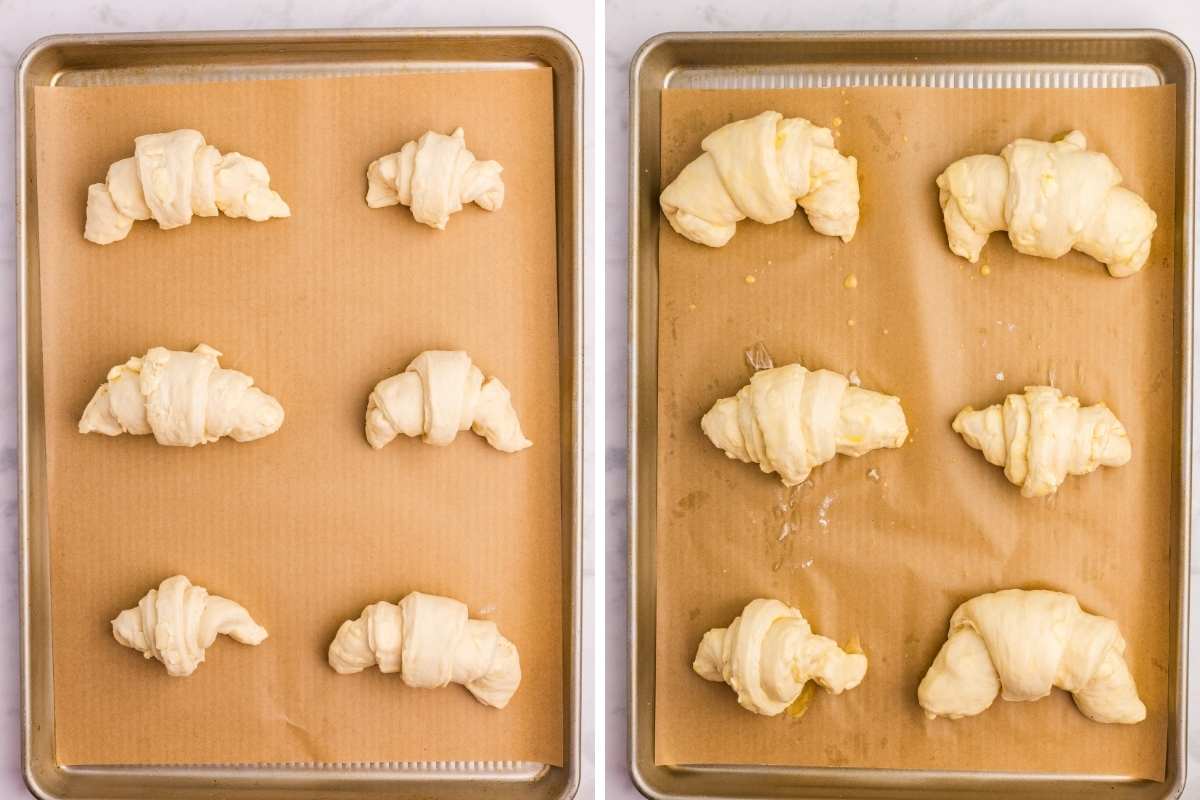
You’re not looking for them to double again…just soft, slightly jiggly, and noticeably lighter.
7. Bake
Preheat your oven to 375°F. Whisk together the egg and water, then gently brush each croissant with the egg wash for that shiny, golden finish.

Bake for about 25 minutes, rotating the pans halfway through. They’re done when the tops are deep golden brown and the bottoms sound hollow when tapped. If they’re browning too fast, tent loosely with foil for the last few minutes.
8. Cool and Enjoy
Let them cool on a wire rack for at least 10 minutes before serving (the inside continues setting as they rest).
Then serve them warm with butter, jam, or honey.
Storage and Make-Ahead Instructions
Make Ahead
You can prep these in stages. Shape them, cover the trays, and refrigerate overnight. In the morning, let them sit out for 45–60 minutes before baking.
You can also pause earlier—after the final fold—by wrapping the dough tightly and chilling up to 24 hours before shaping.
Freeze Before Baking
Freeze after shaping but before the final rise. Arrange on a lined tray, freeze until solid, then transfer to a freezer bag.
When ready to bake, thaw overnight in the fridge, then rise at room temperature for about an hour before baking.
Freeze After Baking
Cool completely, wrap individually, and freeze for up to 2 months.
Reheat straight from frozen at 350°F for 10–12 minutes until crisp and warm.
Room Temperature Storage
Best the day they’re baked, but they’ll keep in an airtight container for up to 2 days.
Re-crisp in a 325°F oven for 5–8 minutes before serving.
Troubleshooting
In short, your dough got too warm!
The butter probably got too warm during folding or proofing. Chill longer between folds and work on a cool surface.
That usually means your layers weren’t sealed well or the dough got too warm. Next time, pinch edges tightly and chill
longer between folds.
Yes, just adjust bake time. Smaller ones take about 15–18 minutes; large bakery-style ones can need closer to 30.
Printable Recipe

Homemade Croissants
Equipment
- 1 stand mixer with dough hook and paddle attachments
- 1 Rolling Pin
- 2 half sheet pans
- 1 offset spatula or silicone spatula
- 1 pizza cutter or sharp knife
- 1 Pastry brush
Ingredients
Base Dough
- 2¼ teaspoons dry active yeast instant yeast works too
- ¼ cup warm water about 90°F
- 2 tablespoons granulated sugar
- 1 cup warm milk 90–100°F; 2% or whole milk both work
- 1½ teaspoons salt
- 1 cup bread flour
- 2½ cups all-purpose flour + more for rolling
- 2 tablespoons unsalted butter room temperature
- 2 tablespoons avocado oil or other neutral-flavored oil
Butter Block
- 2 tablespoons all-purpose flour
- 1 cup unsalted butter softened; 2 sticks
For Brushing
- 1 egg egg for optional egg wash
- 1 tablespoon water for egg wash
Save This Recipe
You'll join my email list which you will love. And if you don't, unsubscribe in one click. ❤️
Instructions
- Make dough. In a stand mixer, combine yeast, warm water, and sugar. Let sit 5 minutes until foamy. Add warm milk, salt, and bread flour; mix to combine. Slowly add all-purpose flour until the dough pulls from the sides of the bowl. Mix in butter and knead about 5 minutes until smooth and soft.
- Risse. Coat a clean bowl with oil. Place dough inside, turn once to coat, and cover. Let rise in a warm place for about 2 hours, or until doubled in size.
- Make butter layer. For the butter layer, beat together 2 tablespoons flour and 1 cup butter until smooth. Spread into a rectangle (about 8×13 inches) on parchment paper. Cover and chill while the dough rises.
- Laminate. Roll risen dough into a large rectangle (about 18×26 inches). Place butter layer on half the dough and fold over to seal. Chill 30 minutes, then roll out and fold into thirds. Repeat this roll–fold–chill process 3 more times (4 total folds), chilling 30 minutes between each.
- Roll out and shape. After the final chill, roll dough into a ½-inch thick rectangle. Cut into 12 long triangles, make a small slit at the wide end, and roll into crescent shapes. Place on parchment-lined baking sheets, cover, and rise 30 minutes.
- Final rise. Place on parchment-lined baking sheets, cover, and rise 30 minutes.
- Bake. Preheat oven to 375°F. Brush tops with egg wash. Bake 25 minutes or until deep golden brown. Cool slightly before serving.
Notes
Nutrition



More to Explore
Hot Pepper Jelly Glazed Wings
Simple Homemade Marinara
How to Make Garlic Powder in a Dehydrator
Homemade Spiced Apple Rings (For Canning)